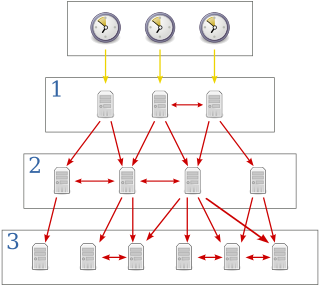Related Research Articles

Internet Protocol version 6 (IPv6) is the most recent version of the Internet Protocol (IP), the communications protocol that provides an identification and location system for computers on networks and routes traffic across the Internet. IPv6 was developed by the Internet Engineering Task Force (IETF) to deal with the long-anticipated problem of IPv4 address exhaustion, and is intended to replace IPv4. In December 1998, IPv6 became a Draft Standard for the IETF, which subsequently ratified it as an Internet Standard on 14 July 2017.
A multicast address is a logical identifier for a group of hosts in a computer network that are available to process datagrams or frames intended to be multicast for a designated network service. Multicast addressing can be used in the link layer, such as Ethernet multicast, and at the internet layer for Internet Protocol Version 4 (IPv4) or Version 6 (IPv6) multicast.
In computing, Internet Protocol Security (IPsec) is a secure network protocol suite that authenticates and encrypts packets of data to provide secure encrypted communication between two computers over an Internet Protocol network. It is used in virtual private networks (VPNs).
Open Shortest Path First (OSPF) is a routing protocol for Internet Protocol (IP) networks. It uses a link state routing (LSR) algorithm and falls into the group of interior gateway protocols (IGPs), operating within a single autonomous system (AS).

Network address translation (NAT) is a method of mapping an IP address space into another by modifying network address information in the IP header of packets while they are in transit across a traffic routing device. The technique was originally used to bypass the need to assign a new address to every host when a network was moved, or when the upstream Internet service provider was replaced, but could not route the network's address space. It has become a popular and essential tool in conserving global address space in the face of IPv4 address exhaustion. One Internet-routable IP address of a NAT gateway can be used for an entire private network.
A virtual private network (VPN) is a mechanism for creating a secure connection between a computing device and a computer network, or between two networks, using an insecure communication medium such as the public Internet.

The Network Time Protocol (NTP) is a networking protocol for clock synchronization between computer systems over packet-switched, variable-latency data networks. In operation since before 1985, NTP is one of the oldest Internet protocols in current use. NTP was designed by David L. Mills of the University of Delaware.
Explicit Congestion Notification (ECN) is an extension to the Internet Protocol and to the Transmission Control Protocol and is defined in RFC 3168 (2001). ECN allows end-to-end notification of network congestion without dropping packets. ECN is an optional feature that may be used between two ECN-enabled endpoints when the underlying network infrastructure also supports it.
Zero-configuration networking (zeroconf) is a set of technologies that automatically creates a usable computer network based on the Internet Protocol Suite (TCP/IP) when computers or network peripherals are interconnected. It does not require manual operator intervention or special configuration servers. Without zeroconf, a network administrator must set up network services, such as Dynamic Host Configuration Protocol (DHCP) and Domain Name System (DNS), or configure each computer's network settings manually.

Anycast is a network addressing and routing methodology in which a single destination IP address is shared by devices in multiple locations. Routers direct packets addressed to this destination to the location nearest the sender, using their normal decision-making algorithms, typically the lowest number of BGP network hops. Anycast routing is widely used by content delivery networks such as web and DNS hosts, to bring their content closer to end users.
In computer networking, the multicast DNS (mDNS) protocol resolves hostnames to IP addresses within small networks that do not include a local name server. It is a zero-configuration service, using essentially the same programming interfaces, packet formats and operating semantics as unicast Domain Name System (DNS). It was designed to work as either a stand-alone protocol or compatibly with standard DNS servers. It uses IP multicast User Datagram Protocol (UDP) packets, and is implemented by the Apple Bonjour and open source Avahi software packages, included in most Linux distributions. Although the Windows 10 implementation was limited to discovering networked printers, subsequent releases resolved hostnames as well. mDNS can work in conjunction with DNS Service Discovery (DNS-SD), a companion zero-configuration networking technique specified separately in RFC 6763.
IP multicast is a method of sending Internet Protocol (IP) datagrams to a group of interested receivers in a single transmission. It is the IP-specific form of multicast and is used for streaming media and other network applications. It uses specially reserved multicast address blocks in IPv4 and IPv6.
The domain name .local is a special-use domain name reserved by the Internet Engineering Task Force (IETF) so that it may not be installed as a top-level domain in the Domain Name System (DNS) of the Internet. As such it is similar to the other special domain names, such as .localhost. However, .local has since been designated for use in link-local networking, in applications of multicast DNS (mDNS) and zero-configuration networking (zeroconf) so that DNS service may be established without local installations of conventional DNS infrastructure on local area networks.
The Dynamic Host Configuration Protocol version 6 (DHCPv6) is a network protocol for configuring Internet Protocol version 6 (IPv6) hosts with IP addresses, IP prefixes, default route, local segment MTU, and other configuration data required to operate in an IPv6 network. It is the IPv6 equivalent of the Dynamic Host Configuration Protocol for IPv4.
An IPv6 transition mechanism is a technology that facilitates the transitioning of the Internet from the Internet Protocol version 4 (IPv4) infrastructure in use since 1983 to the successor addressing and routing system of Internet Protocol Version 6 (IPv6). As IPv4 and IPv6 networks are not directly interoperable, transition technologies are designed to permit hosts on either network type to communicate with any other host.
The Link-Local Multicast Name Resolution (LLMNR) is a protocol based on the Domain Name System (DNS) packet format that allows both IPv4 and IPv6 hosts to perform name resolution for hosts on the same local link. It is included in Windows Vista, Windows Server 2008, Windows 7, Windows 8 and Windows 10. It is also implemented by systemd-resolved on Linux. LLMNR is defined in RFC 4795 but was not adopted as an IETF standard.
This is a comparison of operating systems in regard to their support of the IPv6 protocol.
The Stream Control Transmission Protocol (SCTP) is a computer networking communications protocol in the transport layer of the Internet protocol suite. Originally intended for Signaling System 7 (SS7) message transport in telecommunication, the protocol provides the message-oriented feature of the User Datagram Protocol (UDP), while ensuring reliable, in-sequence transport of messages with congestion control like the Transmission Control Protocol (TCP). Unlike UDP and TCP, the protocol supports multihoming and redundant paths to increase resilience and reliability.
In computer networking, TCP Fast Open (TFO) is an extension to speed up the opening of successive Transmission Control Protocol (TCP) connections between two endpoints. It works by using a TFO cookie, which is a cryptographic cookie stored on the client and set upon the initial connection with the server. When the client later reconnects, it sends the initial SYN packet along with the TFO cookie data to authenticate itself. If successful, the server may start sending data to the client even before the reception of the final ACK packet of the three-way handshake, thus skipping a round-trip delay and lowering the latency in the start of data transmission.

Multicast routing is one of the routing protocols in IP networking.
References
- ↑ Templin, Fred L.; Gleeson, Tim; Thaler, Dave (March 2008). "Intra-Site Automatic Tunnel Addressing Protocol (ISATAP) RFC 5214". tools.ietf.org. IETF Network Working Group. doi: 10.17487/RFC5214 . Retrieved 25 November 2020.
Category: Informational
- ↑ itojun (2002-12-25). "Request to publish ISATAP". v6ops Mailing List. Retrieved 2015-02-09.
- ↑ "Cisco IOS IPv6 Command Reference" . Retrieved 2015-05-06.
- ↑ Peter Marcotullio (2005-03-15). "SRI International's statement about IPR claimed in draft-ietf-ngtrans-isatap-24.txt" . Retrieved 2015-02-09.
- ↑ Fred L. Templin (2007-11-29). "IPV6: Add RFC4214 support" . Retrieved 2015-02-09.
- ↑ Sascha Hlusiak (2010). "ISATAP client for Linux" . Retrieved 2015-02-09.